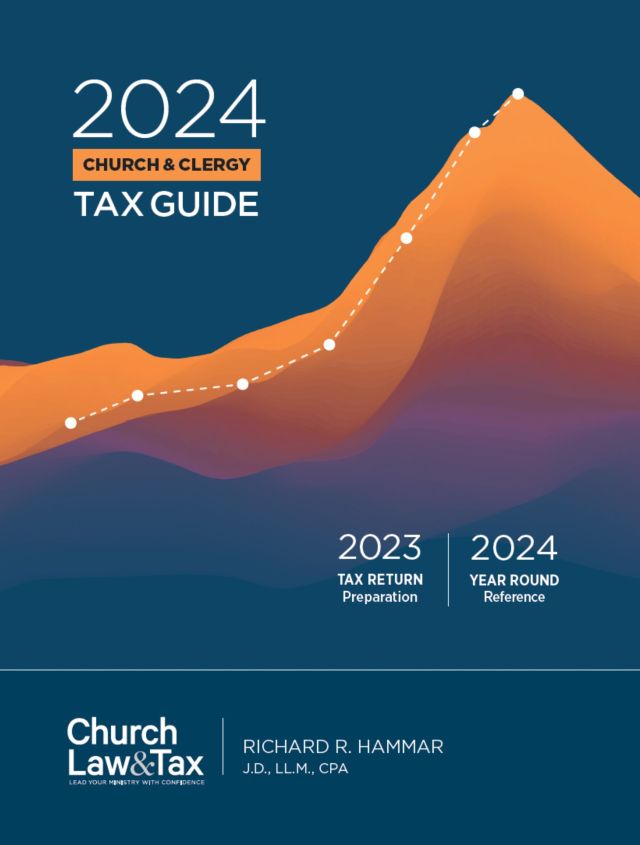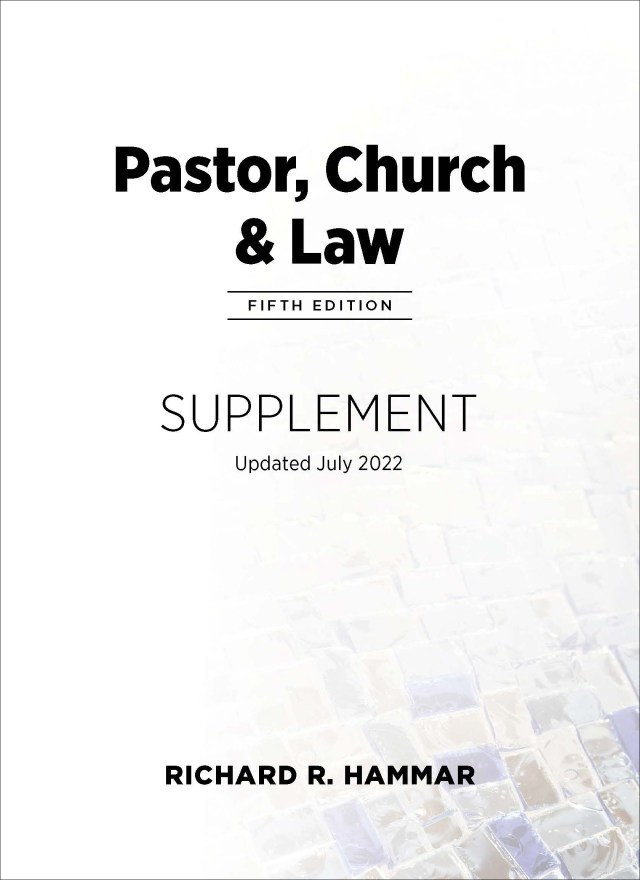Background. Many churches have entered into severance pay arrangements with a pastor or other staff member. Such arrangements can occur when a pastor or staff member is dismissed, retires, or voluntarily resigns. Consider the following examples:
Example 1. Rev. G is hired for a 3-year term at an annual salary of $45,000. After 2 years, the church membership votes to dismiss Rev. G. The church agrees to pay Rev. G “severance pay” in the amount of $45,000 (the full amount of the third year’s salary).
Example 2. Rev. C is called by a church for an indefinite term. After 10 years, Rev. C resigns to accept another position. The church board agrees to pay Rev. C “severance pay” of $20,000.
Example 3. Rev. T accepts a call as a pastor of a local church. After 1 year, she is dismissed and is replaced by a male pastor. Rev. T believes that the church was guilty of sex discrimination. The church and Rev. T enter into a severance agreement in which Rev. T agrees to waive any claims she has against the church under state and federal law in exchange for its agreement to pay her “severance pay” of $40,000 (representing one year’s salary).
Example 4. K has served as bookkeeper of her church for 20 years. She is 68 years old. The church board decides that it is time for K to retire so that a younger person can take over her job. When the board learns that K has visited with an attorney, they offer her a severance pay of one year’s full salary ($25,000).
Is severance pay taxable income? Is severance pay paid by a church taxable income to the recipient? In most cases, the answer is yes. The tax code imposes the income tax on “all income from whatever source derived,” unless a specific exclusion applies. The severance pay described in examples 1 and 2 (above) would be taxable under this general rule. There is one “exclusion” that will apply in some cases. Section 104 of the tax code excludes from taxable income “the amount of any damages received (whether by suit or agreement and whether as lump sums or as periodic payments) on account of personal injuries or sickness.” What does this language mean? Simply this—severance pay that is intended to settle personal injury claims may be nontaxable. The words “personal injuries” are defined broadly by the IRS and the courts, and include potential or threatened lawsuits based on discrimination and harassment. The severance pay described in examples 3 and 4 (above) may be nontaxable based on this section of the tax code.
Key point. The Tax Court has noted that “payments for terminating and canceling employment contracts are not payments for personal injuries.” Matray v. Commissioner, 56 T.C.M. 1107 (1989).
The IRS and the courts have addressed the section 104 exclusion of severance pay based on personal injuries in several rulings. Here are a few examples.
Case 1. A company asked a female manager to resign because it was not satisfied with her management style. The employee retained an attorney who threatened to sue the company for sex discrimination. The employee’s attorney worked out a severance agreement with the company in which the employee agreed to resign and release the company from all legal claims in exchange for a full year’s salary plus other benefits. The employee assumed that the continuation of her salary for one year represented “damages received … on account of personal injuries” under section 104 of the code and accordingly was not taxable. The Tax Court disagreed, based on the following considerations: (1) the company paid the employee an additional year’s salary “to reward her for her past services and to make her severance as amicable as possible”; (2) the severance agreement “contained no express reference to a sex discrimination claim, stating instead that the payment arose from the company’s dissatisfaction with the employee’s managerial style; (3) the company withheld taxes from the severance payments and issued the employee a W-2 reporting these payments as taxable income; (4) the company continued a number of employee benefits, including health insurance, for an additional year; and (5) the severance agreement was similar to other severance agreements the company executed with other officers who were asked to resign. Based on these considerations the Tax Court concluded that the severance pay that was paid to the former employee did not represent damages payable on account of a sex discrimination or other personal injury claim. Britell v. Commissioner, T.C Memo. 1995-264.
Case 2. An employee was dismissed by a company, and later threatened to sue the company for the emotional distress he had suffered. To avoid a lawsuit, the company entered into a severance agreement with the employee in which the employee released all legal claims against the company in exchange for its promise to pay him a cash settlement. The agreement stated the company “intends to treat all payments made hereunder as wages for purposes of any withholding obligation the company may have in order to avoid any penalties and interest which might otherwise accrue.” The Tax Court ruled that the severance pay was taxable income to the employee and not nontaxable damages payable as a result of personal injuries. The court noted that an employee’s belief that he has “certain claims relating to personal injuries … does not establish that the [severance] payments were made on account of personal injuries.” Further, the court pointed out that the company withheld taxes on the payments, and that such withholding “is a significant factor” in classifying the payments as taxable income. Nagourney v. Commissioner, 57 T.C.M. 954 (1989).
Case 3. A company offered older workers an “early retirement” option. Under this option, older workers signed a severance agreement in which they agreed to resign and to release the company from any age discrimination claims in exchange for a continuation of their salary for one year and continued medical insurance. The IRS ruled that the amounts paid to workers who accepted the early retirement option were not excludable from taxable income as a settlement of a personal injury claim. The IRS based this decision on the following considerations: (1) Section 1.61-2(a)(1) of the income tax regulations specifies that severance pay “is income to the recipient unless excluded by law.” (2) “Provisions that exempt income from taxation are to be construed narrowly.” (3) “The burden of proof is on the taxpayer to show that the requirements imposed by the Code are met in order to be entitled to an exclusion from [taxable income].” (4) The existence of a severance agreement in which an employee waives any discrimination claims that he or she has against an employer does not by itself establish that amounts payable under the agreement represent nontaxable damages to settle a personal injury claim. The IRS pointed out that the employee “never filed a lawsuit or any other type of claim against [the employer] alleging age discrimination. A payment cannot be characterized as damages for personal injuries where there is no indication that personal injuries actually exist.” IRS Letter Ruling 9331007.
Key point. The Tax Court has ruled that “damages are not excludable under section 104 if … the damages were received upon the prosecution of economic rights arising out of a contract.” Guidry v. Commissioner, 67 T.C.M. 2507 (1994).
Tips for church treasurers. Here are some factors, based on the above cases, to assist in deciding whether a severance payment made to a former worker represents taxable compensation or nontaxable damages in settlement of a personal injury claim:
- Purpose of the payment. An amount paid to a former employee “to reward her for her past services and to make her severance as amicable as possible” is taxable compensation.
- Reference to a discrimination claim. An amount paid to a former employee under a severance agreement that contains no reference to a specific discrimination or other personal injury claim is taxable compensation.
- Did the church issue a W-2? If an employer pays a former employee severance pay, and reports the severance pay on a W-2 (or 1099), this is strong evidence that the amount represents taxable compensation.
- Continuation of employee benefits. If an employer continues one or more employee benefits (such as health insurance) as part of a severance agreement, this suggests that any amount payable under the agreement represents taxable compensation.
- Similar to other agreements. If a severance agreement is similar to other severance agreements an employer entered into with other employees, this suggests that amounts payable under the agreements represent taxable income.
- Were taxes withheld? If an employer withholds taxes from amounts paid under a severance agreement, this “is a significant factor” in classifying the payments as taxable income. Of course, this factor will not be relevant in the case of ministers whose wages are not subject to withholding (unless they elect voluntary withholding).
- What is the payment called? Referring to a payment as “severance pay” indicates that it is taxable compensation rather than nontaxable damages in settlement of a personal injury claim. Remember, section 1.61-2(a)(1) of the income tax regulations specifies that severance pay “is income to the recipient unless excluded by law.”
- Exclusions are narrowly interpreted. The Supreme Court has ruled that “provisions that exempt income from taxation are to be narrowly construed.” United States v. Centennial Savings Bank, 111 S. Ct/ 1510 (1001). Any reasonable doubts about the correct classification of a particular payment should be resolved in favor of taxation rather than exclusion. Also remember this—the “burden of proof” is on the one claiming an exclusion.
- Was severance pay based on salary? Severance pay based on a former employee’s salary (such as one year’s salary) are more likely to be viewed as taxable compensation rather than nontaxable damages in settlement of a personal injury claim. As the IRS has noted, “where payments made by an employer to its employees are excludable from the employee’s taxable income as damages for personal injury under section 104 of the Code, those payments are not remuneration for services performed by an employee for an employer, and therefore are not considered wages for purposes of the Code.” IRS Letter Ruling 9331007.
- An actual personal injury claim must exist. To be nontaxable, severance pay must represent “damages” received in settlement of a personal injury claim. The income tax regulations defines the term “damages received” as “an amount received (other than workmen’s compensation) through prosecution of a legal suit or action based upon tort or tort type rights, or through a settlement agreement entered into in lieu of such prosecution.” Treas. Reg. § 1.104-1(c). The IRS has noted that this language requires more than a settlement agreement in which a former employee “waives” any discrimination or other personal injury claims he or she may have against an employer. If the employee “never filed a lawsuit or any other type of claim against [the employer] … the payment cannot be characterized as damages for personal injuries” since “there is no indication that personal injuries actually exist.” IRS Letter Ruling 9331007.
Caution. Church treasurers must determine whether severance pay is taxable so that it can be properly reported (on a W-2 and the church’s 941 forms). Also, taxes must be withheld from severance pay that is paid to nonminister employees (and ministers who have elected voluntary withholding). Failure to properly report severance pay can result in substantial penalties for both a church and the recipient.
What about a housing allowance? A related question is whether a church can designate any portion of severance pay as a housing allowance. This question has never been addressed by either the IRS or any court. However, an argument can be made that a church can designate a portion of severance pay as a housing allowance if the severance pay is treated as taxable compensation rather than as damages in settlement of a personal injury claim. If the severance pay represents taxable income, as the IRS will almost certainly insist in most cases, it is because the amount paid represents compensation based on services rendered. Since a housing allowance must be designated out of compensation paid to a minister for services rendered in the exercise of ministry, a reasonable case can be made that a housing allowance can be designated with respect to taxable severance pay.
Of course, a housing allowance can only be designated for ministers. And, the designation of a housing allowance will be of little value if the minister transfers immediately to another church that designates a timely housing allowance. But a designation of a housing allowance will be useful in the case of a minister who is not immediately employed by another church or religious organization. Note that there is no guaranty that this position will be accepted by either the IRS or the courts. All that can be said is that in many cases this position will have a reasonable basis and therefore no penalties will be assessed in the event the position is not allowed in an audit.
Also, note this—housing allowances are not reduced by the portion of a minister’s compensation that represents vacation pay, even though the minister ordinarily is not performing services in the exercise of ministry during vacation. The same principle supports the availability of a housing allowance designated out of a minister’s severance pay.
Key point. The Older Workers Benefit Protection Act of 1991, which applies to any employer with 20 or more employees that is engaged in interstate commerce, prohibits employees at least 40 years of age from “waiving” their rights under federal age discrimination law unless the waiver meets several specific requirements, including the following: (1) the waiver is in simple language; (2) the waiver specifically refers to rights arising under the federal Age Discrimination in Employment Act; (3) the employee does not waive rights or claims that may arise after the date the waiver is executed; (4) the employee must receive some benefit for signing the waiver in addition to salary; (5) the individual is advised in writing to consult with an attorney prior to executing the agreement; (6) the individual is given a period of at least 21 days within which to consider the agreement; and (7) the agreement provides that for a period of at least 7 days following the execution of such agreement, the individual may revoke the agreement. This law will not apply to most local churches, since they have fewer than 20 employees. Even churches with 20 or more employees are not subject to these requirements unless they are engaged in interstate commerce.
This article originally appeared in Church Treasurer Alert, October 1995.




